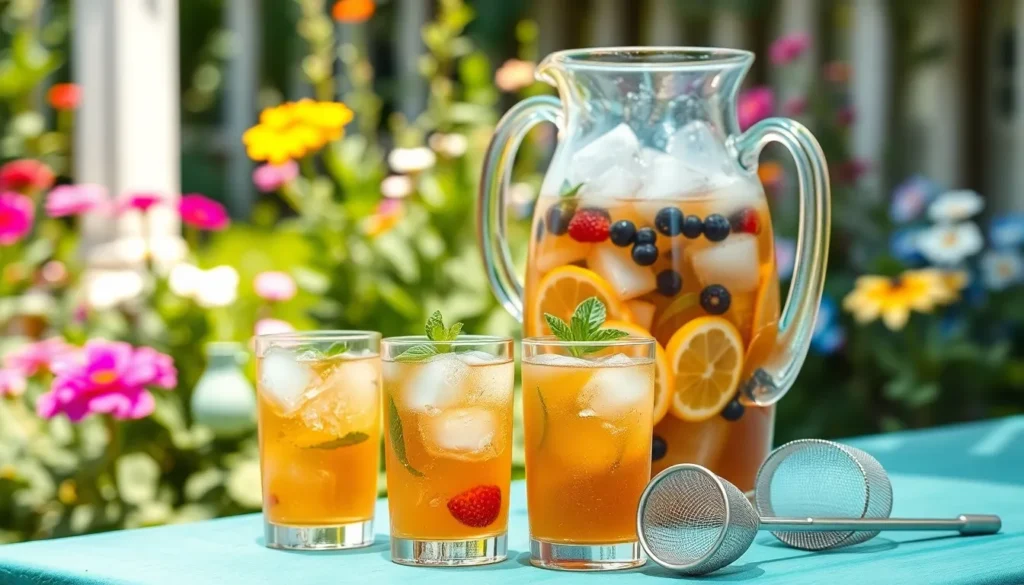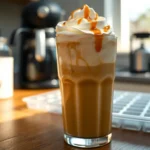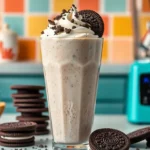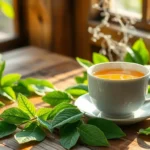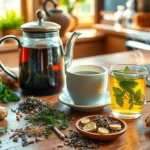When summer heat strikes and you’re craving something refreshing, nothing beats the smooth and mellow taste of cold brew iced tea. Unlike traditional hot-brewed tea that’s cooled down, this method steeps tea leaves in cold water for hours, creating a naturally sweet and less bitter beverage that’s perfect for those scorching afternoons.
We’ve discovered that cold brewing extracts the tea’s best flavors while leaving behind the harsh tannins that can make regular iced tea taste astringent. The result? A silky-smooth drink that’s naturally refreshing without needing loads of sugar or artificial sweeteners.
The best part about making cold brew iced tea is how incredibly simple it is. You’ll need just two ingredients and a bit of patience while time does all the work for you. Whether you’re hosting a backyard barbecue or just want to stay cool during your morning commute, this foolproof method will become your go-to summer drink recipe.
Equipment Needed
Making cold brew iced tea requires minimal equipment that you likely already have in your kitchen. We recommend gathering these essential items before beginning the brewing process.
A large glass jar or pitcher serves as the primary brewing vessel for steeping tea leaves in cold water. We prefer using a 64-ounce mason jar or glass pitcher with a wide mouth for easy access when adding tea leaves and stirring. Glass containers work best because they don’t absorb flavors or odors that could affect the tea’s taste.
Fine mesh strainers become crucial for removing tea leaves after the steeping process. We suggest using a strainer with holes small enough to catch loose tea particles while allowing the liquid to flow freely. Double straining through cheesecloth creates an even clearer final product.
Measuring cups ensure accurate ratios between tea leaves and water. We use both liquid measuring cups for water and dry measuring cups for loose tea leaves to maintain consistency across batches.
Storage containers keep your finished cold brew iced tea fresh in the refrigerator. We recommend using airtight glass bottles or pitchers that seal properly to preserve flavor and prevent contamination. Swing-top bottles work exceptionally well for individual servings.
A long-handled spoon helps with initial stirring and mixing of tea leaves with cold water. We find that wooden or stainless steel spoons work best without scratching glass surfaces.
Tea infusers or large tea bags can substitute for loose tea leaves if you prefer easier cleanup. We recommend using spacious infusers that allow tea leaves room to expand fully during the steeping process.
Ingredients
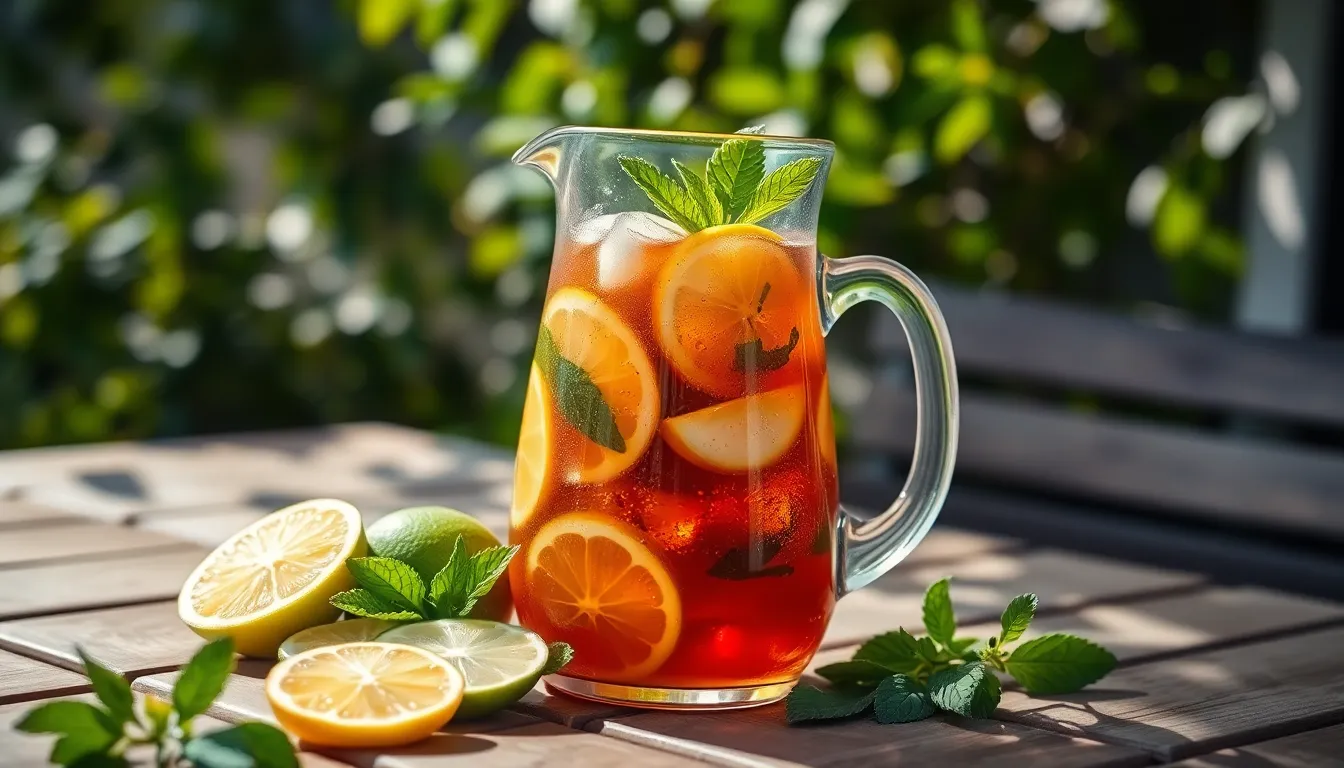
Creating our perfect cold brew iced tea requires just a few essential components and opens up endless possibilities for customization. We’ll start with the basics and then explore flavor enhancements that transform this simple beverage into something extraordinary.
For Basic Cold Brew Iced Tea
Tea Selection and Ratio
- Tea bags: 1 tea bag per 6–8 ounces of water for standard strength
- Loose-leaf tea: 1–1.5 teaspoons per cup of water, adjusting based on desired intensity
- Cold filtered water: Use the highest quality water available for the cleanest taste
Essential Equipment
- Large pitcher or jar: Glass, plastic, or food-safe container with secure lid
- Fine mesh strainer: For removing loose tea leaves after brewing
- Measuring tools: Accurate ratios ensure consistent results every batch
Optional Flavor Additions
Citrus Elements
- Fresh lemon slices: Add brightness and natural acidity to enhance tea flavors
- Lime wheels: Provide tropical notes and subtle tartness
- Orange segments: Contribute sweet citrus complexity without overpowering
Aromatic Herbs
- Fresh mint sprigs: Create cooling sensation and refreshing finish
- Basil leaves: Offer unexpected herbal depth and sophisticated taste
- Rosemary branches: Deliver earthy, pine-like aromatics for unique flavor profiles
Natural Sweeteners
- Honey: Dissolves easily in cold liquid and adds floral sweetness
- Pure cane sugar: Classic choice that balances bitter tea compounds
- Agave nectar: Provides neutral sweetness without masking tea character
- Liquid stevia: Zero-calorie option for health-conscious tea drinkers
- Sliced berries: Strawberries, blueberries, or raspberries infuse subtle fruit essence
- Peach wedges: Add natural sweetness and summery stone fruit notes
- Cucumber ribbons: Create spa-like refreshment with clean, crisp flavor
Instructions

Follow these simple steps to create perfectly smooth and refreshing cold brew iced tea. The process requires minimal effort but delivers maximum flavor through patient steeping.
Prep
Combine tea and cold water in your glass or plastic pitcher using the proper ratios. Add 1 tea bag or 1½ teaspoons of loose tea per cup of cold filtered water to ensure optimal flavor extraction.
| Tea Type | Water Amount | Tea Amount |
|---|---|---|
| Tea bags | 1 cup | 1 tea bag |
| Loose tea | 1 cup | 1½ teaspoons |
Mix the ingredients gently with a long-handled spoon to ensure all tea leaves are properly saturated with water. Cover the pitcher to prevent any refrigerator odors from affecting your tea’s delicate flavor profile.
Steeping Process
Place the covered pitcher in your refrigerator for the cold brewing process. Allow the tea to steep for 6 to 12 hours for optimal flavor development, though some prefer extending the steeping time up to 24 hours for stronger taste.
Cold brewing at lower temperatures creates a milder and smoother flavor profile with significantly less bitterness and astringency compared to hot brewed tea. The extended steeping time compensates for the lower temperature by allowing thorough flavor extraction without harsh tannins.
Check your tea periodically to monitor the strength and adjust steeping time according to your taste preferences. Lighter teas like white or green varieties often require shorter steeping times due to their delicate flavor compounds.
Straining and Storage
Remove tea bags carefully from the pitcher once your desired steeping time is complete. For loose tea leaves, strain the mixture through a fine mesh strainer into a clean pitcher to remove all leaf particles.
Add simple syrup or flavored syrups after straining if you prefer sweetened tea, stirring gently to incorporate the sweetener evenly throughout. Fresh fruit or herbs can also be added at this stage for additional flavor customization.
Store your finished cold brew iced tea in the refrigerator in a covered container for up to 3 days. Keep the tea properly covered to maintain freshness and prevent absorption of other refrigerator flavors that could compromise the clean taste profile.
Serving Suggestions
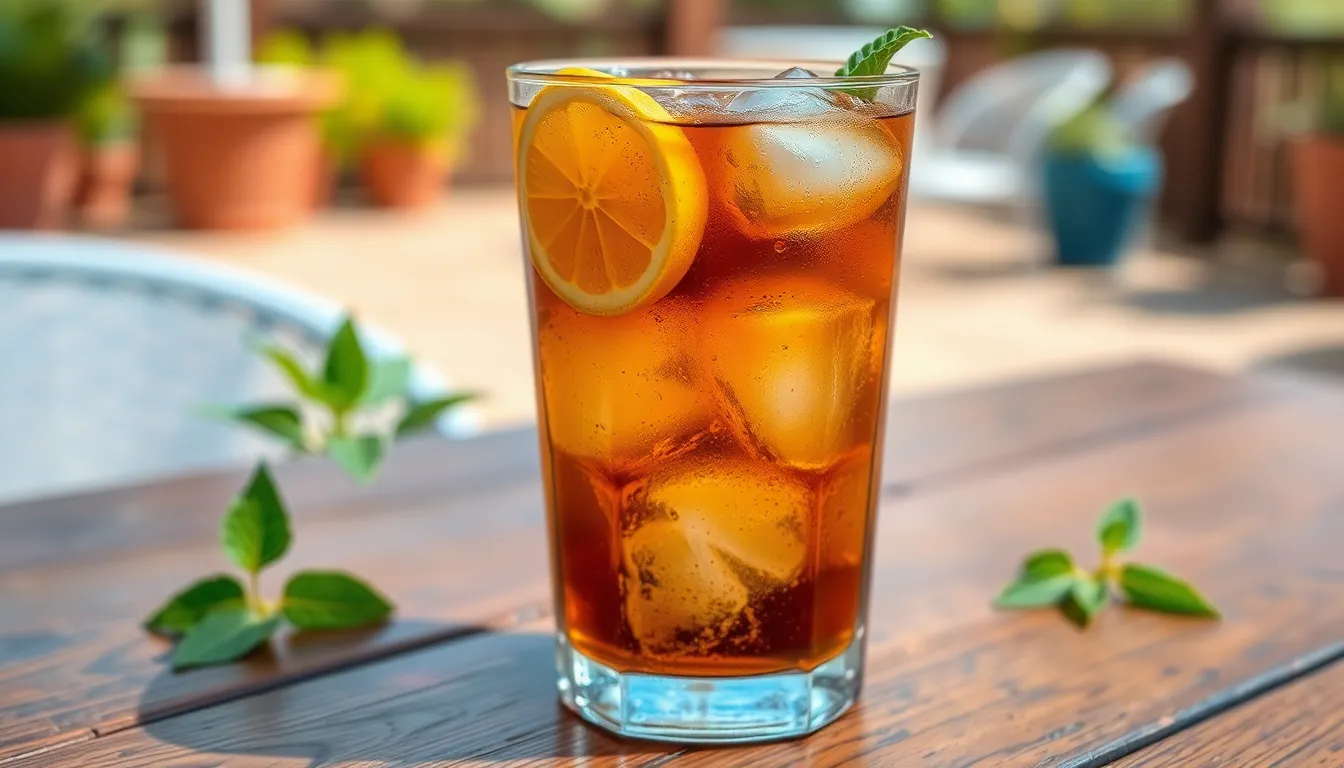
Transform your cold brew iced tea into an extraordinary beverage with thoughtful additions that enhance both flavor and presentation. We recommend exploring various combinations to discover your perfect glass of refreshment.
Ice and Garnishes
Adding ice to your cold brew tea maintains its refreshing quality throughout every sip. We suggest using large ice cubes or ice spheres to minimize dilution while keeping the temperature perfectly chilled.
Fresh garnishes elevate both the visual appeal and taste profile of your cold brew. Sliced lemons bring bright citrusy notes that complement any tea variety. Lime wheels add a zesty twist that pairs beautifully with herbal blends. Orange slices introduce subtle sweetness that works especially well with black teas.
Fresh herbs create aromatic experiences that transform ordinary iced tea into something special. Mint leaves provide cooling properties and classic appeal. Basil offers an unexpected herbal complexity that surprises and delights. We particularly enjoy the way these herbs release their essential oils when gently muddled at the bottom of the glass.
Sweetening Options
Natural sweeteners blend seamlessly into cold brew tea without overpowering the delicate flavors. Honey dissolves easily and adds floral notes that complement fruit-forward teas. Maple syrup brings rich complexity that pairs exceptionally with robust black teas. Agave nectar provides clean sweetness that allows the tea’s natural characteristics to shine through.
Traditional sweeteners offer reliable results for those who prefer classic approaches. Regular sugar creates a neutral sweetness that works with any tea variety. We recommend dissolving sugar completely by stirring thoroughly or creating a simple syrup beforehand.
Flavored syrups open up endless customization possibilities. Vanilla syrup enhances dessert-like teas and creates cafe-style beverages at home. Fruit syrups like raspberry or peach add concentrated flavor without additional preparation time. These options allow us to create signature drinks that reflect personal preferences and seasonal ingredients.
Flavor Variations
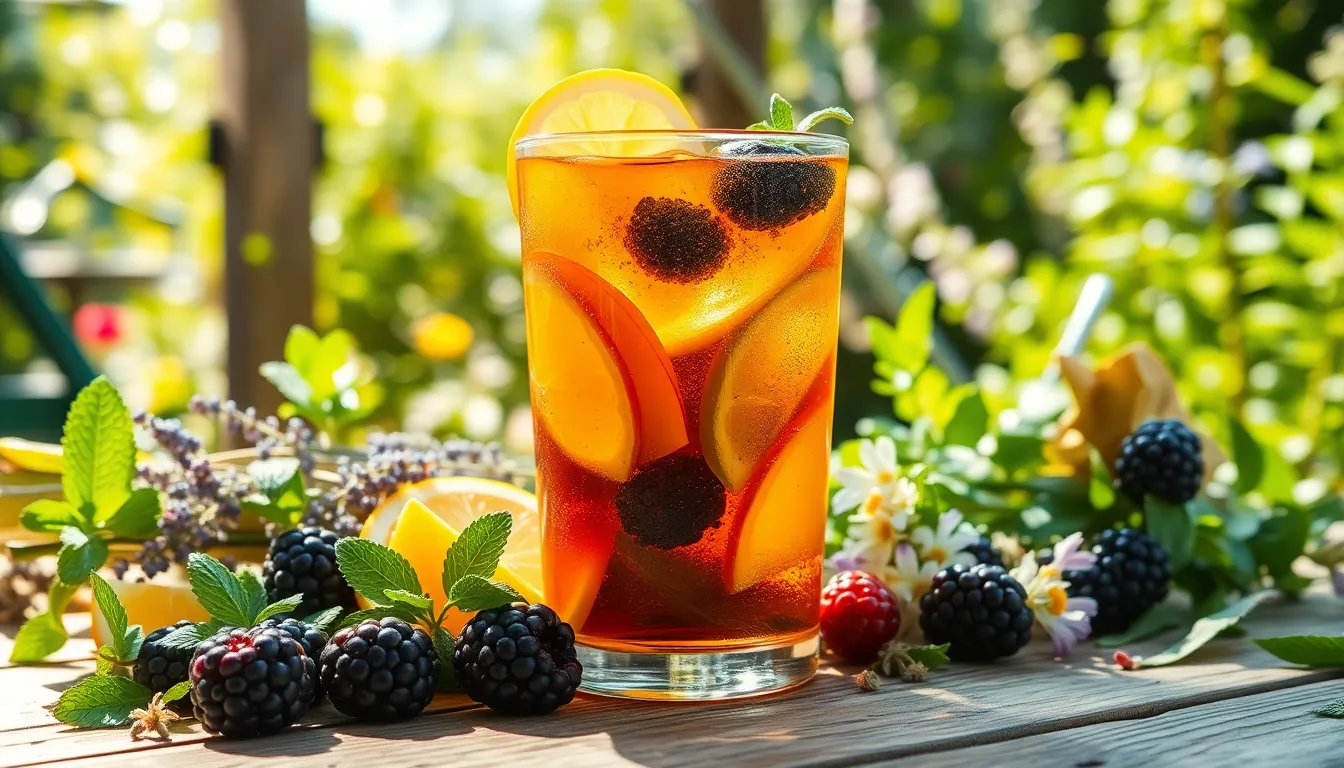
Cold brew iced tea transforms into countless delicious combinations through creative flavor additions and tea base selections. We can explore exciting variations that enhance the naturally smooth cold brewing process with fruits, herbs, and spices.
Fruit Infused Cold Brew Tea
Fresh fruit additions create vibrant and refreshing cold brew iced tea variations that burst with natural sweetness. We love adding lemon slices, mango chunks, blackberry, and watermelon pieces directly to our brewing container for maximum flavor infusion. Citrus juices from oranges, limes, and grapefruits blend seamlessly with the cold brewing process and add bright acidity.
Commercial fruit-infused options offer convenient alternatives with flavors like Fruity Thai, Mango Gusher, and Fruit Bomb that combine real tea leaves with natural fruit essences. These pre-sweetened varieties deliver zero calories and sugar-free enjoyment while maintaining authentic fruit flavors. Mixing our finished cold brew tea with fruit punch or fresh lemonade creates another layer of fruity complexity that appeals to all taste preferences.
Frozen fruit works exceptionally well as both flavoring agent and natural ice cubes that won’t dilute our carefully crafted brew. We recommend muddling berries gently at the bottom of glasses before adding cold brew tea for intense fruit flavor throughout each sip.
Herbal Blend Options
Herbal tea blends open up caffeine-free cold brewing possibilities that deliver soothing and aromatic iced tea experiences. We frequently use hibiscus as our base ingredient because it provides tart and vibrant flavor profiles that pair beautifully with fruit essences like blackberry for fresh tangy combinations. Chamomile creates gentle floral notes that work perfectly for evening relaxation drinks.
Mint leaves add cooling aromatic qualities that make hot summer days more bearable when combined with our cold brewing method. We often blend different herbs together, mixing chamomile with mint or adding aronia for unique flavor depth. These herbal combinations steep beautifully in cold water over extended periods and develop complex flavor profiles without any bitterness.
Fresh herb combinations like basil and lavender create sophisticated flavor profiles that elevate our cold brew iced tea beyond traditional expectations. We recommend experimenting with seasonal herbs from our gardens to discover personalized herbal blend recipes.
Spiced Tea Variations
Spiced cold brew variations offer subtle aromatic complexity through careful spice selection and extended steeping periods. We achieve the best results by adding whole spices like cinnamon sticks, cardamom pods, and whole cloves directly to our tea leaves before beginning the cold brewing process. These spices release their essential oils slowly during the long steeping time and create delicately spiced beverages.
Ground spices work differently in cold brewing and require careful measurement to avoid overpowering the tea base. We typically use half the amount of ground spices compared to whole spices because their flavors extract more quickly even in cold water. Star anise and whole allspice berries add warming notes that complement black tea bases particularly well.
Creating spice blends inspired by traditional chai recipes works wonderfully for cold brewing when we adjust the ratios for longer steeping times. These subtly spiced cups develop complex flavor layers that become more pronounced as the tea chills and the spices continue their slow extraction process.
Storage and Make-Ahead Tips
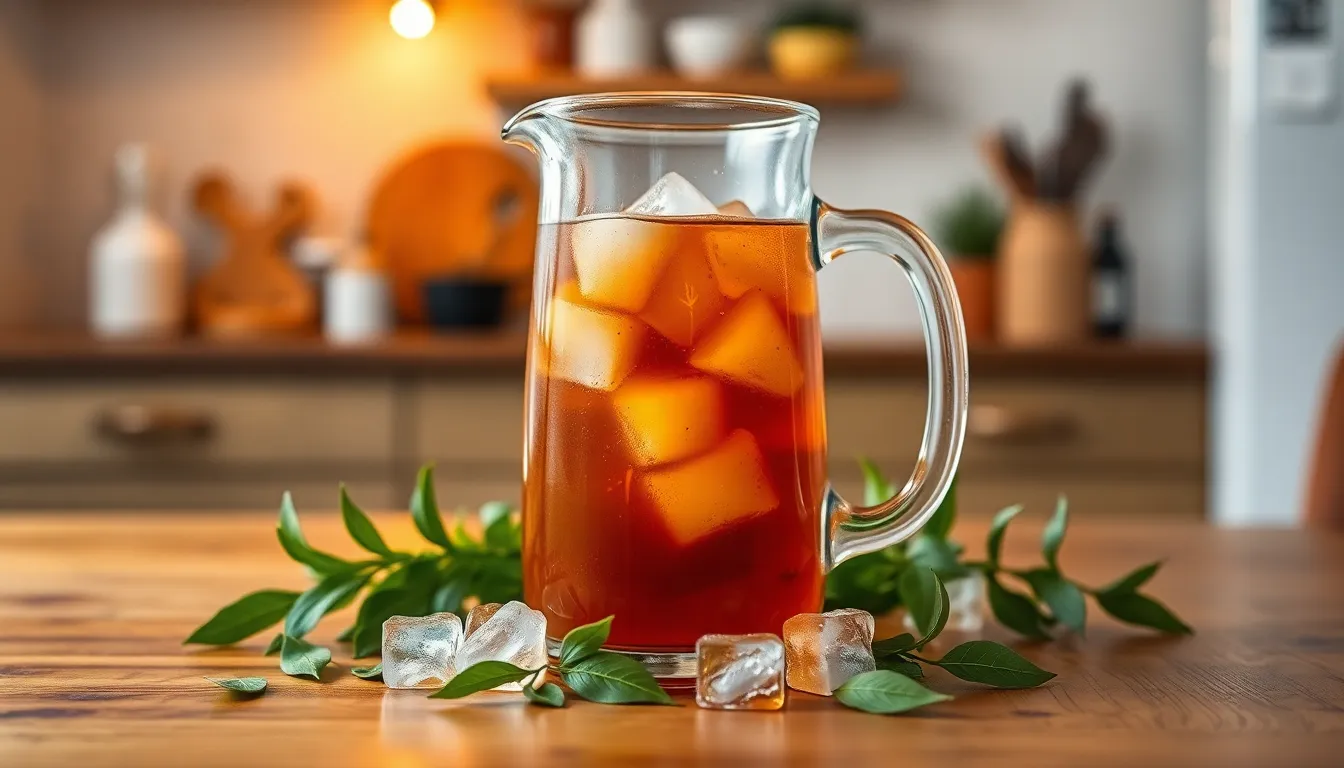
We can prepare cold brew iced tea well in advance to ensure we always have refreshing beverages ready for any occasion. The steeping process requires patience but minimal active preparation time.
Optimal Steeping Schedule
Planning our cold brew preparation around steeping times maximizes convenience. We recommend placing our tea in the refrigerator before bedtime for perfectly brewed tea by morning. Different tea varieties require exact steeping durations for optimal flavor extraction:
| Tea Type | Steeping Time |
|---|---|
| Green tea | 6-8 hours |
| White tea | 6-8 hours |
| Black tea | 8-12 hours |
| Oolong tea | 8-12 hours |
| Pu-erh tea | 8-12 hours |
| Herbal tea | 8-12 hours |
We should taste our tea periodically during the steeping process to determine when it reaches our desired flavor profile. This approach prevents over-extraction and ensures consistent results every time.
Proper Storage Guidelines
Our finished cold brew iced tea maintains peak freshness when stored correctly in the refrigerator. We can keep our prepared tea for 3 to 5 days depending on the ingredients used. Always store the tea in covered pitchers to prevent contamination and preserve the delicate flavors we’ve carefully extracted.
Glass containers work best for maintaining flavor integrity without absorbing odors from other refrigerated items. We recommend straining out all tea leaves or removing tea bags completely before storage to prevent continued steeping and potential bitterness.
Make-Ahead Strategies
Batch preparation serves us well when entertaining or maintaining daily tea supplies. We can prepare multiple pitchers using different tea varieties to offer guests various flavor options. The tea-to-water ratio of 1 to 1.5 teaspoons of loose-leaf tea per 8 ounces of water ensures consistent strength across batches.
Our cold brew tea serves as an excellent base for tea cocktails and iced milk teas like boba or lattes. We can prepare plain cold brew tea ahead of time and customize individual servings with sweeteners or lemon according to personal preferences just before serving.
Troubleshooting Common Issues
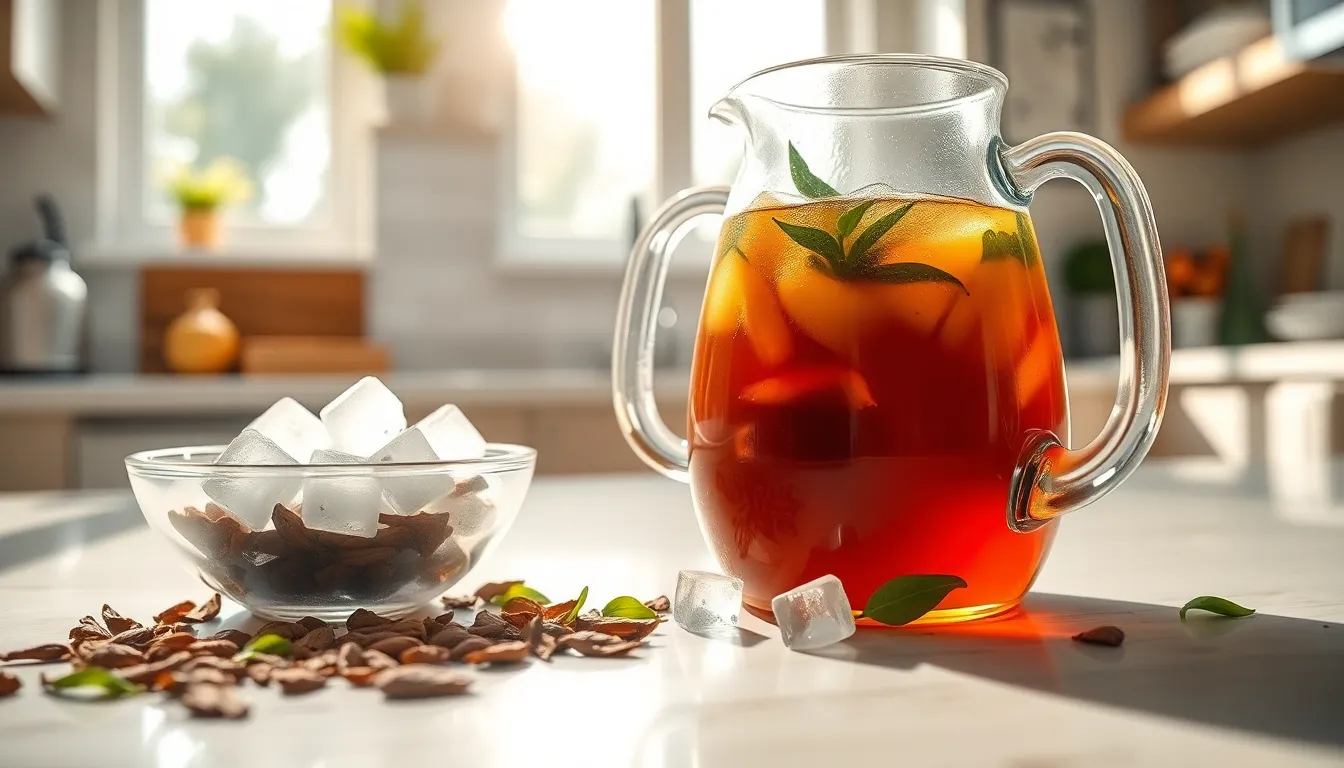
Even with the simplest brewing methods, we sometimes encounter challenges when making cold brew iced tea. Understanding these common problems helps us achieve consistently delicious results every time.
Weak or Flavorless Tea
When our cold brew tastes too light or lacks the robust flavor we expect, the solution lies in adjusting our tea-to-water ratio. Cold water extracts flavors more slowly than hot water, requiring us to use more tea leaves than traditional hot brewing methods. We recommend starting with 1 teaspoon of loose leaf tea per cup of water and increasing gradually until we reach our desired strength.
The type of tea we choose also impacts flavor intensity. Black teas and robust green teas typically produce stronger cold brews than delicate white teas or herbal blends. Testing different varieties helps us discover which teas work best for our taste preferences.
Bitter or Unpleasant Taste
Overstepping creates the most common cause of bitter cold brew iced tea. While cold brewing reduces bitterness compared to hot brewing, leaving tea leaves in water too long still produces harsh flavors. We should monitor our steeping times carefully, aiming for 8 to 12 hours for most tea varieties.
Different teas require different steeping windows. Green teas often reach optimal flavor in 6 to 8 hours, while black teas can steep for 10 to 12 hours without becoming bitter. We keep detailed notes about timing for each tea type to ensure consistent results.
Stale or Flat Flavor
Fresh ingredients make all the difference in cold brew quality. Using stale tea leaves produces flat, lifeless flavors that no amount of steeping time can improve. We store our tea in airtight containers away from light and heat to maintain freshness.
Water quality significantly impacts the final taste of our cold brew. Filtered or spring water eliminates chlorine and mineral flavors that can mask the tea’s natural characteristics. We avoid using tap water when possible, especially in areas with heavily treated municipal water supplies.
| Common Issue | Primary Cause | Solution | Steeping Time Adjustment |
|---|---|---|---|
| Weak flavor | Insufficient tea leaves | Increase tea-to-water ratio | Extend by 2-4 hours |
| Bitter taste | Over-extraction | Reduce steeping time | Decrease by 2-3 hours |
| Stale flavor | Old tea leaves or poor water | Use fresh tea and filtered water | No change needed |
Temperature fluctuations during steeping can also affect flavor development. We keep our brewing containers in the main refrigerator compartment rather than the door, where temperatures vary more frequently. Consistent cold temperatures ensure even extraction throughout the steeping process.
Conclusion
Cold brew iced tea transforms your summer beverage routine with its effortlessly smooth and naturally sweet profile. We’ve shown you how this simple two-ingredient method creates a refreshing drink that’s perfect for any occasion from casual afternoons to entertaining guests.
The beauty of cold brewing lies in its flexibility and convenience. You can prepare large batches ahead of time customize flavors to your taste and enjoy consistent results every time. Whether you prefer classic black tea fruit-infused varieties or herbal blends the cold brew method delivers exceptional flavor without the bitterness.
Start experimenting with your favorite tea combinations today and discover why cold brew iced tea has become our go-to summer refreshment. Your taste buds will thank you for making the switch to this game-changing brewing technique.
Frequently Asked Questions
What is cold brew iced tea and how is it different from regular iced tea?
Cold brew iced tea is made by steeping tea leaves in cold water for 6-12 hours, rather than brewing with hot water and cooling it down. This method produces a smoother, naturally sweeter, and less bitter beverage because it extracts fewer harsh tannins from the tea leaves.
How long should I steep cold brew iced tea?
Steep cold brew iced tea for 6-12 hours in the refrigerator. Light teas like white and green tea need about 6-8 hours, while black teas and herbal blends can steep for 8-12 hours. Adjust the time based on your taste preference for stronger or milder flavor.
What’s the proper tea-to-water ratio for cold brew iced tea?
Use 1 tea bag per cup of water or 1 tablespoon of loose-leaf tea per cup of water. For a stronger concentrate, you can increase the ratio to 1.5 tablespoons per cup. Always use cold, filtered water for the best taste results.
What equipment do I need to make cold brew iced tea?
You need a large glass jar or pitcher for steeping, fine mesh strainers to remove tea leaves, measuring cups for accurate ratios, and storage containers. A long-handled spoon for mixing and tea infusers are optional but helpful for easier preparation and cleanup.
How long does cold brew iced tea last in the refrigerator?
Cold brew iced tea stays fresh for 3-5 days when stored in covered glass containers in the refrigerator. Keep it consistently cold and avoid leaving it at room temperature for extended periods to maintain optimal flavor and prevent spoilage.
Can I add flavors to cold brew iced tea?
Yes! Add fresh citrus slices, herbs like mint or basil, natural sweeteners like honey or agave, and fresh fruits like berries or peaches. You can infuse these flavors during the steeping process or add them when serving for customized taste combinations.
Why does my cold brew iced tea taste weak or bitter?
Weak tea usually means insufficient steeping time or too little tea. Increase the tea-to-water ratio or steep longer. Bitter tea often results from over-steeping or using poor-quality water. Use fresh, filtered water and monitor steeping times carefully for optimal flavor.
What types of tea work best for cold brewing?
Most teas work well for cold brewing, including black, green, white, oolong, and herbal teas. Black teas create robust flavors, while green and white teas offer delicate, refreshing tastes. Herbal blends like hibiscus and chamomile provide caffeine-free options with unique flavor profiles.

